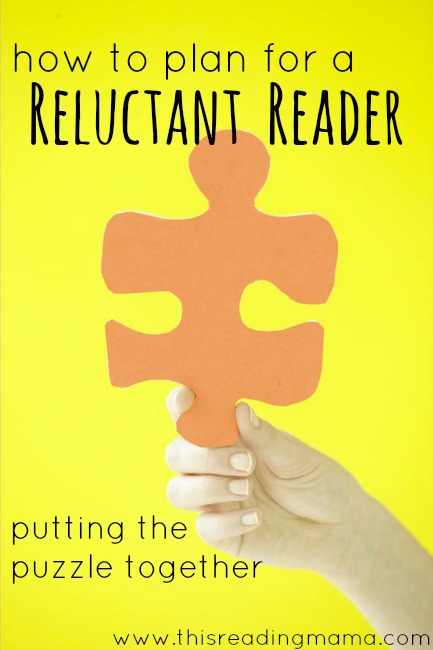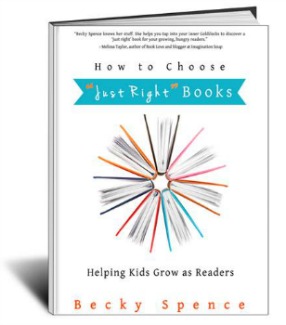Teaching reluctant readers can be like putting together a puzzle that’s missing several pieces. And, if we’re honest, sometimes teaching them is like putting together a puzzle that’s missing the overall picture. There are so many factors that can make readers reluctant, making it hard to plan for them. In this post, I hope to provide you with resources for some of those missing puzzle pieces. I pray that these resources will be a blessing to you and your reluctant reader.
*This post contains affiliate links.
1. Many Reluctant Readers Lack Interest and Motivation
 {photo credit}
{photo credit}
Let’s just call it like it is. Some reluctant readers hate reading. As reluctant readers age, a by-product of struggling to read is a low reading esteem. This directly impacts motivation; or lack of. Sometimes, this is an “easy” fix. Sometimes it is not. Here are a few suggestions when planning for readers who lack the motivation to pick up that text and read:
- A steady diet of reading on his/her reading level. These are texts the child can read AND comprehend without much assistance. If you’re not sure how to pick those “just right” texts, you will find TONS of tips and practical help for doing so in my book How to Choose “Just Right” Books: Helping Kids Grow as Readers.
- Find a younger reading buddy. Older readers (who are reading on a lower level) may find those “baby” books more tolerable if they’re reading them to younger children.
- Readers (not just reluctant readers) like to read about subjects for which they are interested. Even if the texts are below or above their reading level, texts that interest them are a great option. I love Melissa’s list in chapter 12 of Book Love and refer to it quite often.
- Read non-fiction. This is always a great place to start because the reluctant reader can pick texts on topics that interest him.
- Readers need to be told what they are doing right. Are they going back and correcting mistakes? Are they able to answer “easy” questions about the text? Is he using the pictures to help him figure out unknown words? Praise your reluctant reader for the things he’s doing right. I also love Amy’s list on things never to say to reader.
- Re-work text when appropriate. Sometimes reluctant will be more willing to read a “baby” book if the pictures are removed from the text. To do this, type up the text onto a single sheet of paper and let them read.
- Read poetry. Shel Silverstein or Jack Prelutsky poetry was always a favorite of the struggling and reluctant readers that I tutored. The short text, humor, and lower reading level made these ideal.
- Read aloud to the child; even if the child is older. Find texts that may be too hard for the child to read that are of high interest to her and read it together. Sometimes, reluctant readers get stuck in the mindset that reading equals saying the words right and they forget that reading is all about enjoyment and understanding. Reading aloud helps to make this part come alive. (Listening to books on CD or an iPod/iPad would also work.)
2. Many Reluctant Readers are Actually Struggling Readers
 {photo credit}
{photo credit}
It may be that your reluctant reader is missing important puzzle pieces in one or more of these areas: letters and their sounds, phonological awareness, phonics, word identification (with sight words), fluency, & comprehension. Any one of these missing skills can directly affect reading. Here are a few online resources you can check out when planning for these puzzle pieces:
Letters and Their Sounds
Use the alphabet assessment tool found in my Reading Readiness pack to help you figure out which letters/sounds your child does or does not know.
- Start with learning the letters in their name
- Work on learning the alphabet. I have free ABC printable packs just for this!
- We have over 100 Alphabet Activities and Printables, too!
- Reading the Alphabet–a FREE reading curriculum to take young readers a little deeper into their ABC’s, book/print awareness, & phonological awareness
- Sound Tubs– these are fun to make yourself and hands-on for learning letters and their sounds
- See more alphabet goodies on my ABC Pinterest board
Phonological and Phonemic Awareness
What is phonological awareness? Simply put, it’s being able to recognize and manipulate the sounds in words. Phonemic awareness is under the umbrella of phonological awareness and is being able to recognize and manipulate the individual sounds (or phonemes) within words. Children with a good understanding in phonological and phonemic awareness can recognize and create rhyming words, blend and separate syllables, isolate beginning and ending sounds on words, blend sounds together to make words, and separate sounds within words.
- 7 Day Series on Phonological and Phonemic Awareness with free activities and printables
- My Reading Readiness Checklist has some assessment tools for phonological and phonemic understanding.
- Working on rhyming? You can incorporate rhyme into your routine or into your read aloud time. I also have created a FREE Rhyme Time packet for my young reader. We also have a DUPLO Rhyming Match Up, a Rhyming Fishing Game, and a Roll-a-Rhyme Pack that my tot and preschooler have enjoyed.
- Working on phonemes? Try these phoneme counting cards or this phoneme pack…both free!
- Each lesson of my Reading the Alphabet has a few phonological awareness activities sprinkled in (thus far, the main focus is on rhymes and syllable segmentation)
- Games like Poke n’ Peek Syllables are fun for struggling readers and sure beat any worksheet!
- Michelle also has a great list of activities that strengthen phonemic awareness
- For more information and activities related to phonological and phonemic awareness, visit my series of posts on the subject.
Word Identification and Fluency
Sight Words (also sometimes known as high frequency words) are a huge part of reading. How much so? The first 100 words alone on Fry’s list make up 50% of what you read! Amazing. It goes without saying that if kids can’t automatically recognize these important words, fluency (and comprehension) are compromised. What are some ways you can plan sight word learning for your reader?
- While there is a Dolch list of sight words, I prefer Fry’s first 100 words, listed in order of frequency and that’s the order I recommend. Start with the first 5 and move on from there.
- Sight Word Games, like this one, make learning fun. Learning sight words through play is definitely NOT boring! This post has an entire list of the sight words games we played this past summer. I also have quite a few more sight word games on my sight word Pinterest board
- Reading the Easy Way– Beth has developed a sight word program that she sells- she now has a Level 1 and Level 2. If you’re interested, you can read my review of Level 1.
- Sight Words You Can See– uses imagery, mnemonics, and humor to help learn those irregular words.
- Start a Word Wall– this is where you store all of the sight words your child has learned thus far. ALuv (in 1st grade) has 5 sight words a week that we focus upon. After the week is over, I place them on his word wall and hold him accountable for reading and spelling them correctly.
- Consider your child’s word development. Are you expecting too much? Sometimes sight words don’t “stick” because your child is not developmentally ready.
- Technology- our three favorite apps for working on sight words are Word BINGO , Magnetic ABC (my 1st grader spells his words on here) & Teach Me 1st Grade. Samson’s Classroom is another computer program that we use about once to twice a week.
- Sight word identification and fluency are kissing cousins. If your child struggles with fluency, try some of the activities in this post. Find reading passages that lend themselves to reading with expression (characters talking, poetry, etc.) and try echo reading.
Phonics
While recognizing words by sight is important, this is not the only strategy that readers need to learn. Reading by analogy (using known words and word chunks to help them read unknown words) is also an important skill and one that proficient readers still use. If you’ve followed my blog for very long, you’ve probably noticed that my absolute favorite way to teach phonics is through Word Study: a developmental study of the patterns within words. When planning out your phonics program, here are some tools for your box:
- What exactly is Word Study? Check out my 10 day series “Teaching Spelling Through Word Study“. Word study isn’t just a spelling thing; it’s a reading thing as well.
- How do you know which phonics skills are missing? Try the phonics assessment section of Cool Tools0p or give your child a spelling inventory. These will show you the holes in their word understanding.
- I love picture and word sorts. My free Phonics by The Book curriculum has a word sort for each lesson. I have even started creating seasonal word sorts, focusing upon certain phonics features, with my latest one being a Christmas picture sort.
- Start with word families. And to make that easier, 3 Dinosaurs has some FREE word family printables, starting with short a.
- Manipulate words with magnetic letters, Making Words, or other hands-on ways
- BOB Books– I love the way that BOB Books teach phonics in a systematic fashion. And as a fun side project, a few bloggers and I are working to create FREE printables to accompany the BOB Books. Our next one will go live on January 14th. There are also two apps for the BOB Books: BOB Books #1 & BOB Books #2. You can try these apps for FREE here.
- I have used Words Their Way over the years for word study, but if you’re a homeschooler, Spelling Mechanics Homeschool Word Study is a great program (and Ann is super helpful!).
- I have collected more helpful planning tips and activities on my Word Study Pinterest board
Comprehension
Sometimes, reluctant readers don’t have any issues with recognizing words automatically or reading by analogy. These readers can actually read texts well beyond their years. But ask them a question about what they just read and you’ll get a blank stare or the infamous, “I don’t remember” answer. Here are some things to consider when planning for them:
- What are some comprehension strategies? Click here to read about them.
- Explicitly model and teach comprehension strategies- I love the way Amy of Teach Mama posts about this in her learning through read aloud series.
- Starting January 7th, Carolyn of The Wise Owl Factory will be doing a 5 day series on Reading Comprehension. I am super excited to read and learn from her. You may also want to check out other bloggers tackling literacy that week.
- Sometimes, students don’t understand the text structure of fiction or nonfiction; which affects their ability to weed out important from not-so-important pieces of the text. Text features within nonfiction may also need to be taught, as these features aid in comprehension.
- Again, reading aloud to your child helps your child see that reading isn’t just about “barking” the words; its about enjoyment
- I also have a Pinterest board for comprehension strategies. You may find more resources there, including some great anchor charts for comprehension.
3. Some Reluctant Readers Have Deeper Issues that Affect their Reading
 {photo credit}
{photo credit}
If reading has become something both you and your child want to avoid at all costs, there may be more going on…something deeper. Some kids have a shorter attention span, which can cause stress when asked to sit for long periods of time to read. Sometimes, there are processing issues like dyslexia. If you’ve “tried everything” and you (and your child) are still frustrated, then check out these resources:
- Start by documenting what you observe. Does she struggle with phonics? Is he frequently reversing letters, even in the 5th grade? Is she frequently unable to answer those questions that require her to read between the lines?
- Take your documented observations to someone knowledgeable about reading disorders (your child’s pediatrician may have a referral for someone in your area). A local school may also have some great referrals.
- If you think your child may have dyslexia, read more about it here or you can take an online test for dyslexia
- To read more about red flags, check out Melissa’s post: When to Worry About Your Child’s Reading
- For more information on struggling learners in general, check out Jennifer’s post: Planning Homeschool for the Struggling Learner
Books I Recommend for Reluctant and Struggling Readers
In my book, How to Choose “Just Right” Books: Helping Kids Grow as Readers, I have practical tips and advice for knowing what a “just right” text is for your child. This is important for ANY kind of reader, but especially reluctant and struggling readers. It can be purchased for $3.99.
Reluctant & Struggling Readers
- What Really Matters for Struggling Readers by Richard Allington
- Book Love by Melissa Taylor
- The Book Whisperer: Awakening the Inner Reader in Every Child by Donalyn Miller
Phonics & Sight Words
- Phonics They Use by Patricia Cunningham
- What Really Matters in Spelling by Patricia Cunningham
- Words Their Way by Bear et. al
Comprehension
- Strategies that Work by Stephanie Harvey
- 7 Keys to Comprehension: How to Help Your Kids Read it and Get it by Zimmermann
- Improving Comprehension Through Think-Alouds by Jeffrey Wilhelm
- Reading with Meaning by Debbie Miller
- Summarizing, Paraphrasing, and Retelling (upper elementary and middle school students) by Emily Kissner
- The Art of Teaching Reading (if you’d like a good, but LONG read) by Lucy Calkins
Older Readers
- Rip-Roaring Reads for Reluctant Teen Readers by Gale Sherman
- More Rip-Roaring Reads for Reluctant Teen Readers by Bette Ammon
- You’ve Got to be Kidding– a book recommended for readers 8+ by Thinking IQ Blog
- Most Popular Books for Teens
Additional Blog Posts and Sites for Reading Help
- 10 Things Struggling Readers Need {This Reading Mama}
- 5 Tips for Getting Reluctant Readers Reading {A Mom with a Lesson Plan}
- How to Motivate Reluctant Readers {Playdough to Plato}
- Help! My Child Doesn’t Like Books! {In Lieu of Preschool}
- 7 Ideas for a Child Who Thinks Books are Boring {Imagination Soup}
- 7 Tips to Encourage Your Beginning Reader {Mom 2 Posh Lil Divas}
- 10 Tips for Read-Aloud Learning {Teach Mama}
- Homeschooling with Dyslexia {Abundant Life Blog}
- Spelling Mechanics Homeschool Word Study
- Reading Rockets
- Beginning Reading Help
- The Tutor House
- Struggling Reader Pinterest Board (where I collect my favorite online resources)
Want to read more homeschooling “How To” posts? Click here or on the image above.
Stay connected to This Reading Mama so you don’t miss a thing:
- Subscribe by email {get really cool FREEBIES when you do!}
- Google+
~Becky





Really helpful-I need to go over the resources slowly. Having learned to read quickly and easily using “look and say”, it has come as a bit of a shock to have a child who has found learning to read slow and difficult. Probably doesn’t help that I’ve had to learn phonics properly for the first time!
This is a really helpful post for all parents. Thanks for putting it together. We’d love for you to share it in our After School Link Up this week. We use our Love Books approach with our children from very early on and it’s had such a great affect on our children. http://www.theeducatorsspinonit.blogspot.com/2012/12/intro-to-abcs-of-after-school.html
Excellent post Becky! Lots of great resources. I’m sharing with my readers. 🙂
Lots of great resources here. I look at learning to read like putting a puzzle together too. There are many thought processes working together in a competent reader. Figuring out what an early reader needs to learn early is very important I think. Struggling readers have a difficult time changing their thinking patterns while reading as they get older. If a reader is not using all the necessary thought processes, they practice reading in a way that makes it harder for them to incorporate the missing pieces as they get older.
I hope some parents and teachers are able to figure out missing pieces and use some of your resources to catch a few struggling readers early. The work you put into this post will benefit others. Nice work. I’m sharing this post in a few places today. Happy New Year to you and yours!
Thank you for sharing, Michelle! 🙂
Wow, so much great information!! Thank you so much!
This is wonderful! i am sharing it with my student teachers who are completing reading practicums, and my colleagues who teach reading methods!! 🙂 (and on my blog as well!)
Thank you, Sarah!!
thanks for mentioning Book Love and Imagination Soup!!
You’re so welcome! It truly is an amazing book!
I have a reluctant reader who is older than my younger reader, the younger child is advanced and reads books to the older child. Can this help the older child at all?
I’m sure there are many benefits of the younger sibling reading to the oldest. I would offer just three words of caution: 1- be very careful that you or the youngest child is not making any negative comments about your youngest child being able to read better than your oldest and 2- make sure that your youngest isn’t doing the work for the oldest. When your oldest is “stuck” or unable to read something, do not let your younger child jump in save the day. Reluctant readers often have the strategies in their heads, but the motivation to pull up those strategies is in neutral. 🙂 3- Make sure you give them time each day to read separately so that the reluctant reader is reading books of her choice and level. Hope that helps. Great question.
Becky, it’s like all in one encyclopaedia for struggling readers! What a wonderful post – I am glad you pulled it out of your archives. I am going to be pinning and sharing it.
What a terrific article – thoughtful and full of useful resources. A very generous and interesting post – thank you!